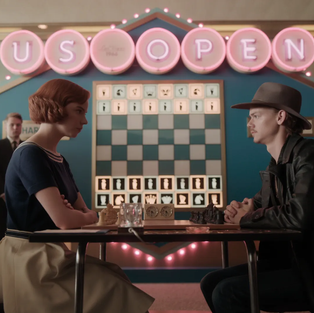FIT FOR A QUEEN?
- Steven Anderton

- Jan 8, 2021
- 3 min read
Along with 63 million households around the globe (making it Netflix's biggest scripted series to date) lockdown number 3 has enabled me to binge watch The Queen's Gambit. The limited series about an orphaned chess prodigy called Beth Harmon, I admit, didn't initially spark my imagination until I was informed by a good friend "you need to watch it, you'll love the interiors"

Set in the '50s and '60s, The Queen's Gambit is a delight for all fans of mid-century modern design, bringing to life the beauty of this iconic period onto our screens.

Fictionally set in Kentucky, USA and showcasing some impressive backdrops as she travels the world to compete in her chess-playing tournaments ranging from Paris to Moscow, the show oozes style and glamour. However, unbeknownst to the majority of viewers, most of the series was actually filmed in and around Berlin, a city I personally love.
The shows Production Designer Uli Hanisch told Architectural Digest why Berlin was chosen to replicate Cincinnati, Las Vegas, Mexico City, Paris and Moscow;
"Because of the history of Berlin being separated by west and east, we have a lot of this kind of Western-world orientated architecture from the '60s where West Berlin was trying to show off to be part of the Western World, while East Berlin was looking straight to Moscow" Uli Hanisch
Whilst some of the external scenes for Kentucky were filmed in Toronto, Canada, Hanisch and set decorator Sabine Schaaf built the interior sets in a huge studio in Berlin. Vintage furniture was drafted in from the Netherlands along with Berlin prop houses supplying items to recreate the mid-century modern look.
Without spoiling the plot too much, Beth finds herself moving into a home with a lady; a sweet woman called Alma. Her home is a plethora of bold layered patterns, with the living room predominantly decorated in a single colour, teal. Mid-century modern furniture like star-burst clocks, Formica furniture and trinkets such as ceramic cat ornaments adorned the home of the lovable Mother figure.

Hanisch and Schaaf transformed numerous spaces in Berlin, many of them being completely dressed in one night due to time constraints with them being public buildings still in daily use. One of the most impressive scenes for me was the Hotel Mariposa in Las Vegas, which in fact is an event venue called Palais am Funkturm in a district of Berlin.

Designed in the '50s by Bruno Grimmek, this unique event space hosts the largest ballroom in Berlin and features a retractable staircase and a height adjustable chandelier.
Hanisch had to source 40 golden-beige armchairs, 20 turquoise chairs, and 20 mauve sofas from a manufacturer in Berlin that produced the chairs and let the show rent them.
I loved particularly how Beth Harmon's hotel room was styled in true gaudy Vegas style with turquoise, white and brown hues, diamond motifs, gold-trimmed cushions and bold fan patterns on the curtains, bedspread and chairs. Hanisch made a conscious effort to make all the hotel rooms distinctly different for each destination Beth travelled too.
“Las Vegas was turquoise and gold,” he says. “Mexico was red, Paris was pale blue, and we ended in Moscow with heavy blacks and white wood.” Uli Hanisch

For Beth's trip to Mexico City, the producers used the lobby of the Friedrichstadt-Palast theatre in the District of Mitte, Berlin to recreate the Art-Deco inspired Aztec Palace Hotel.
The massive structure is the last major building erected by the German Democratic Republic and features gorgeous stained glass windows in the theatre's lobby. It's here that Beth competed in the 1966 International Chess Tournament with her arch rival Borgov.
For the Mexico City hotel room, the set designing team used Osbourne & Little's Trailing Orchid print, which they had to age by using layers of coloured varnish. Several shades of red and burgundy painted on Anaglypta wallpaper adorn the walls and salmon pink bedding against a clashing palm leaf headboard finished the tropical look.
In the final scenes when Beth heads to Moscow, once again it is actually Berlin that provided the setting. From the Altes Stadthaus being transformed into the location for the 1968 Tournament of Champions to the film theatre Kino International being used as her hotel restaurant. You have to applaud Hanisch and his team for being able to transport viewers to different areas of the world; all whilst staying in one fascinating city.
From the elegant clothes to the unmistakable '50s American cars, The Queen's Gambit showcased what the mid-century modern era provided to the world with its distinct style. Not only are the interiors used on the show stunningly beautiful to watch but the series depicts the American design movement which still influences style trends today.
Are you looking for an interior fit for a Queen? If so, here's my edit to get The Queen's Gambit look...
The Queen's Gambit is now playing on Netflix
































































Thanks for featuring my fabric. Very happy to have found you - love your work.